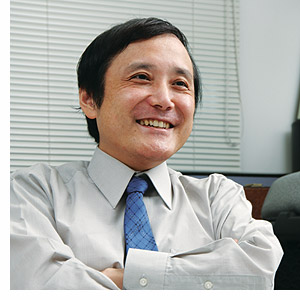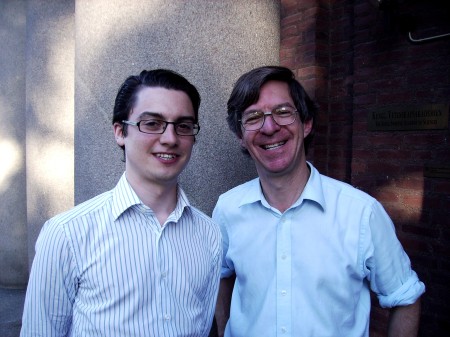 The FANTOM consortium report in the latest issue of Nature Genetics that they have measured what happens with the entire, total, gene expression during the specific differentiation of a cell line called THP-1. Not the expression of just the 10 000 most important genes, all of them. At the same time.
The FANTOM consortium report in the latest issue of Nature Genetics that they have measured what happens with the entire, total, gene expression during the specific differentiation of a cell line called THP-1. Not the expression of just the 10 000 most important genes, all of them. At the same time.
Their findings are a heap of data which is probably larger than the whole body of research on medicine and biology up until the early 1900’s. If I try to say what their main finding is, I’d lean towards the interconnectedness of the signaling network. It doesn’t have one single weak spot, where you could knock out a certain gene and profoundly change the network dynamics. Knock-out of some genes had effects on many other parts of the network, but in general the system seems to be robust because of redundancy and interconnectedness. I have drawn similar conclusions in my own latest paper, though my methodology is a pair of binoculars compared to their multinational telescope.

Professor Hayashizaki of the RIKEN Omics Science Center was the general organiser of this study.
My main thoughts, however, upon reading this paper were not so much about the actual research, but more about the way it was done.
- With the advent of large-scale initiatives like these, we will perhaps have charted most of the “connectome” of the cell within the next decades. This is the map of the decision-making pathways. The neuroanatomy of the cell, if you wish. It has enormous potential to explain how, exactly, things go wrong in diseases such as cancer.
- Biology is starting to resemble some branches of physics, where research advances through large concerted efforts. The author list of this paper is half a page long, with the authors’ affiliations taking up another half page. There will be less space for the nerdy loner scientists and greater demand for the entrepreneurial, outgoing kind of researcher in the future.
- Seventeen figures and fourteen tables, and the whole methods section, have been relegated to the “supplementary material” that is only available online. Reporting on this kind of science in an 8-page article is like writing a short essay on “World War II”. I’m sure the best parts are in there, but you can’t begin to reenact it based on their descriptions. Lots of the interesting sub-analyses, which I presume must have been performed, will never see daylight. This is exactly the sort of science that benefits from the innovation of the online journal. No page limitations are needed there. Just last week, for example, I noticed that PlosOne had published a paper entitled “New Mid-Cretaceous (Latest Albian) Dinosaurs from Winton, Queensland, Australia”, which is 51 pages long and contains 40 illustrations, mainly of various bones photographed from different angles. Try getting that into a conventional journal!
Full reference:
Suzuki, H., Forrest, A., van Nimwegen, E., Daub, C., Balwierz, P., Irvine, K., Lassmann, T., Ravasi, T., Hasegawa, Y., de Hoon, M., Katayama, S., Schroder, K., Carninci, P., Tomaru, Y., Kanamori-Katayama, M., Kubosaki, A., Akalin, A., Ando, Y., Arner, E., Asada, M., Asahara, H., Bailey, T., Bajic, V., Bauer, D., Beckhouse, A., Bertin, N., Björkegren, J., Brombacher, F., Bulger, E., Chalk, A., Chiba, J., Cloonan, N., Dawe, A., Dostie, J., Engström, P., Essack, M., Faulkner, G., Fink, J., Fredman, D., Fujimori, K., Furuno, M., Gojobori, T., Gough, J., Grimmond, S., Gustafsson, M., Hashimoto, M., Hashimoto, T., Hatakeyama, M., Heinzel, S., Hide, W., Hofmann, O., Hörnquist, M., Huminiecki, L., Ikeo, K., Imamoto, N., Inoue, S., Inoue, Y., Ishihara, R., Iwayanagi, T., Jacobsen, A., Kaur, M., Kawaji, H., Kerr, M., Kimura, R., Kimura, S., Kimura, Y., Kitano, H., Koga, H., Kojima, T., Kondo, S., Konno, T., Krogh, A., Kruger, A., Kumar, A., Lenhard, B., Lennartsson, A., Lindow, M., Lizio, M., MacPherson, C., Maeda, N., Maher, C., Maqungo, M., Mar, J., Matigian, N., Matsuda, H., Mattick, J., Meier, S., Miyamoto, S., Miyamoto-Sato, E., Nakabayashi, K., Nakachi, Y., Nakano, M., Nygaard, S., Okayama, T., Okazaki, Y., Okuda-Yabukami, H., Orlando, V., Otomo, J., Pachkov, M., Petrovsky, N., Plessy, C., Quackenbush, J., Radovanovic, A., Rehli, M., Saito, R., Sandelin, A., Schmeier, S., Schönbach, C., Schwartz, A., Semple, C., Sera, M., Severin, J., Shirahige, K., Simons, C., St. Laurent, G., Suzuki, M., Suzuki, T., Sweet, M., Taft, R., Takeda, S., Takenaka, Y., Tan, K., Taylor, M., Teasdale, R., Tegnér, J., Teichmann, S., Valen, E., Wahlestedt, C., Waki, K., Waterhouse, A., Wells, C., Winther, O., Wu, L., Yamaguchi, K., Yanagawa, H., Yasuda, J., Zavolan, M., Hume, D., Arakawa, T., Fukuda, S., Imamura, K., Kai, C., Kaiho, A., Kawashima, T., Kawazu, C., Kitazume, Y., Kojima, M., Miura, H., Murakami, K., Murata, M., Ninomiya, N., Nishiyori, H., Noma, S., Ogawa, C., Sano, T., Simon, C., Tagami, M., Takahashi, Y., Kawai, J., & Hayashizaki, Y. (2009). The transcriptional network that controls growth arrest and differentiation in a human myeloid leukemia cell line Nature Genetics, 41 (5), 553-562 DOI: 10.1038/ng.375



 Posted by evolvingideas
Posted by evolvingideas 



